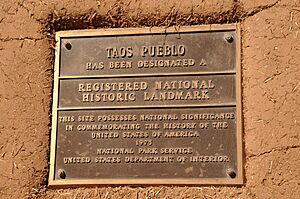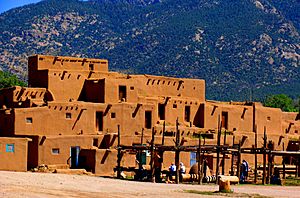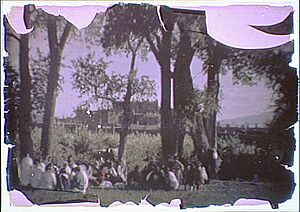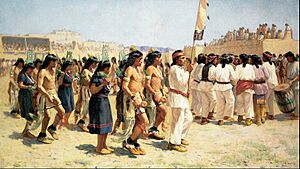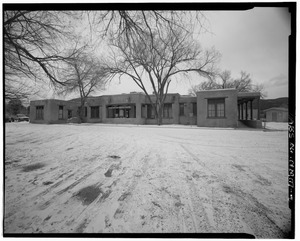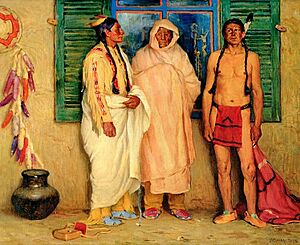Taos Pueblo facts for kids
Quick facts for kids Taos Pueblotə̂otho or tə̂obo ȉałopháymųp’ȍhə́othə̀olbo or ȉałopháybo Pueblo de Taos |
|
|---|---|
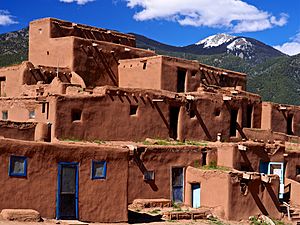
Taos Pueblo in 2017
|
|
| Location | Taos Pueblo, New Mexico, U.S. |
| Governing body | Native American tribal government |
| Official name: Pueblo de Taos | |
| Type | Cultural |
| Criteria | iv |
| Designated | 1992 (16th session) |
| Reference no. | 492 |
| Region | Europe and North America |
| Designated | October 15, 1966 |
| Reference no. | 66000496 |
| Area | 19 acres (7.7 ha) |
| Architecture | Pueblo |
| Designated | October 9, 1960 |
| Designated | March 13, 1972 |
| Reference no. | 243 |
| Lua error in Module:Location_map at line 420: attempt to index field 'wikibase' (a nil value). | |
| t’óynemą | |
|---|---|
| Total population | |
| 4,500 (2010 U.S. census) | |
| Regions with significant populations | |
| Languages | |
| Taos (Tiwa), English, Spanish | |
| Religion | |
| Taos religion (Pueblo religion), Christianity | |
| Related ethnic groups | |
| Other Tanoan peoples |
Taos Pueblo (also known as Pueblo de Taos) is a very old village in New Mexico, United States. It is home to the Taos-speaking people, a Native American tribe. This pueblo is one of the oldest places in the U.S. where people have lived continuously for a very long time. It is located about one mile north of the modern city of Taos, New Mexico. In 1992, Taos Pueblo was recognized as a UNESCO World Heritage Site because of its unique history and culture.
The people of Taos Pueblo are famous for their farming skills and their special adobe-style buildings. They have lived in these same homes for over thirty generations. Even without horses or wheeled vehicles, they built large trade networks across the region. Their location and long-lasting buildings make Taos Pueblo a key example of Pueblo culture. Taos Pueblo is part of the Eight Northern Pueblos. The tribal land covers about 95,000 acres, and around 4,500 people live in this area.
Contents
- Discovering Taos Pueblo's Setting
- Understanding the Names of Taos Pueblo
- A Look at Taos Pueblo's History
- Taos Pueblo's Unique Architecture
- Taos Pueblo's Government and Leadership
- The Spiritual Community of Taos Pueblo
- Taos Pueblo Culture and Traditions
- Community Health and Well-being
- Preserving Taos Pueblo's Heritage
- Visual Arts and Pottery
- Notable Taos Pueblo People
- See also
Discovering Taos Pueblo's Setting
The pueblo was built in a beautiful spot, with the Taos Mountains behind it. A small stream, called Rio Pueblo de Taos or Red Willow Creek, flows right through the middle of the village. This stream gets its water from Blue Lake, or Ba Whyea, which is high up in the nearby mountains.
The most striking part of Taos Pueblo's architecture is its multi-story homes. These reddish-brown adobe buildings stand on both sides of the Rio Pueblo. The Pueblo's website suggests these homes were likely built between the years 1000 and 1450. Taos Pueblo was named a National Historic Landmark on October 9, 1960. Later, in 1992, it became a UNESCO Heritage Site. As of 2010, about 150 people live in the historic pueblo all year round.
Understanding the Names of Taos Pueblo
Taos Language Names
In the Taos language, which is a Northern Tiwa language, the pueblo is called "the village." This can be tə̂otho, meaning "in the village," or tə̂obo, meaning "to/toward the village." The full, proper name for the pueblo is ȉałopháymųp’ȍhə́othə̀olbo, which means "at red willow canyon mouth." A shorter version is ȉałopháybo, meaning "at the red willows." These longer names are often used in special ceremonies.
Spanish Language Names
The English name Taos comes from the Spanish word Taos. The Spanish word probably came from the Taos word tə̂o- for "village." It is thought that the Spanish heard "tao" and added an "-s" to make it sound plural, even though "Taos" is not a plural word in modern Spanish.
A Look at Taos Pueblo's History
Early Pueblo History
It is believed that the Taos Indigenous people, like other Pueblo Indigenous people, moved south from the Four Corners region. They settled along the Rio Grande river. The homes in the Four Corners area were once lived in by the Ancestral Puebloans. A long period of dry weather in the late 1200s might have caused them to move to the Rio Grande, where water was more reliable. However, there is also evidence that the people might have moved due to various reasons, including conflicts.
In its early years, Taos Pueblo was an important trading center. Native groups along the Rio Grande traded with their Plains Tribes neighbors to the northeast. Every fall, after the harvest, Taos Pueblo hosted a big trade fair.
Spanish Arrival and Pueblo Resistance
Spanish explorers first arrived at Taos Pueblo in 1540. They were part of the Francisco Vásquez de Coronado expedition, searching for the rumored Seven Cities of Gold. Around 1620, Spanish Jesuits helped build the first Catholic Church in the pueblo, called the mission of San Geronimo de Taos. Records from that time show that the native people of Taos did not want the church built or the Catholic religion forced upon them.
Throughout the 1600s, cultural tensions grew between the native people and the Spanish colonists. Taos Pueblo was no different. By 1660, the native people killed the resident priest and destroyed the church. The Spanish responded with force. Several years after the church was rebuilt, the Pueblo Revolt of 1680 began. The Catholic church in Taos Pueblo still stands today.
US Control and the 1847 Revolt
During the Mexican-American War, New Mexico came under United States control after the Battle of Santa Fe in August 1846. Charles Bent was chosen as the American territorial governor. Many Taos Pueblo people and Hispanos worried that the new American government would take their land. This was especially concerning because Bent had been involved in land deals under the Mexican government.
On January 19, 1847, Hispanos and Taos Pueblo people started a rebellion against the US government. Tomás Romero led a group of Taos Puebloans to Charles Bent's house in the town of Taos. The governor was killed during the uprising. After Bent and several other Americans died, Colonel Sterling Price, who led US forces in Santa Fe, led an expedition against the rebels. He defeated them at the Battle of Cañada on January 24. The rebels then went inside Taos Pueblo. Price attacked the town and the church where the defenders were hiding with cannons on February 3. The next day, a hole was made in the church wall to fire at those inside. More than 150 people died during this attack. After the US forces took control of Taos Pueblo, Tomás Romero and other leaders of the revolt were captured and faced serious consequences. More battles against US forces continued until July of that year.
Taos Mountain and Blue Lake
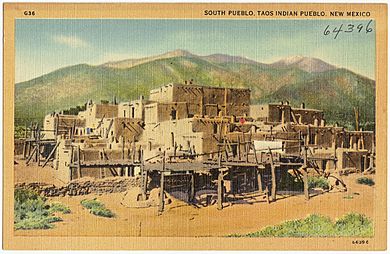
In the early 1900s, President Theodore Roosevelt took 48,000 acres of the Pueblo's mountain land and made it part of the Carson National Forest. This land was finally given back to the Taos Pueblo in 1970 by President Richard Nixon. An additional 764 acres of land, including areas near Blue Lake, were returned to the Pueblo in 1996.
Blue Lake, which the people of the Pueblo consider a sacred place, was part of this land return. The Pueblo worked with non-native people to convince the government to return Blue Lake. They explained that having full access to the lake and its surrounding area was essential for their religious freedom. The Pueblo's website states that getting Blue Lake back was the most important event in their history. This is because they spiritually believe the Taos people originated from the lake. They believe their ancestors live there, and the Pueblo people only go up the mountain for special ceremonies. Blue Lake is also very important for the community's farming, providing the main water supply for growing corn, fruits, beans, and raising cattle and sheep.
Taos Pueblo's Unique Architecture
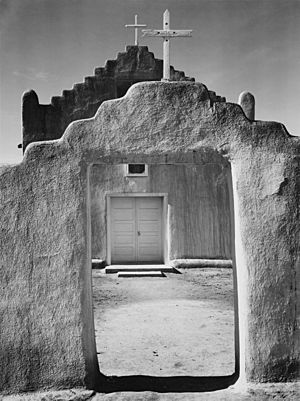
When the Spanish first arrived, explorer Hernando de Alvarado described the pueblo's adobe houses. He noted they were built very close together and stacked five or six stories high. The homes became narrower as they rose, with the roofs of each level serving as floors and terraces for the levels above.
The original buildings at Taos had few windows and no regular doorways. People entered rooms through square holes in the roof, using long wooden ladders to climb up. Engelmann Spruce logs, called vigas, supported the roofs. These roofs were made with layers of branches, grass, mud, and plaster. This building style and the materials used were perfect for the environment and the needs of the people in the Taos Valley. The first Spanish-influenced architecture appeared in Taos Pueblo after Fray Francisco de Zamora arrived in 1598 to start a mission.
Main Structure of the Pueblo
The north-side Pueblo is one of the most photographed and painted buildings in North America. It is the largest multi-story Pueblo structure still standing today. It has adobe walls that are often several feet thick. Its main purpose was for defense. Until about 1900, people entered lower-floor rooms by climbing outside ladders to the roof, then going down an inside ladder. If there was an attack, the outside ladders could be quickly pulled up.
Traditional Homes
The homes in this structure usually have two rooms. One room is for living and sleeping, and the other is for cooking, eating, and storage. Each home is separate, with no hallways connecting them. In the past, Taos Indians used little furniture. Today, they have tables, chairs, and beds. In the historic pueblo, modern electricity, running water, and indoor plumbing are not allowed.
Taos Pueblo's Government and Leadership
Taos Pueblo's government is led by a spiritual and political leader called a cacique. The war chief and their assistants report to the cacique and handle religious duties and community rules. The roles of cacique and war chief are for life. They are chosen by the Tribal Council, which includes former governors who act as advisors. The cacique also chooses a war captain and five assistants each year. These individuals serve as community police and help organize events. Each year, the cacique also selects a Governor and several assistants to represent the Pueblo in dealings with the outside world. These roles are unpaid and are seen as a service to the community.
Today, more young people and women in Taos Pueblo are becoming involved in tribal leadership and community activities. This shows a change from older traditions, which once limited these roles to men over thirty years old.
The Spiritual Community of Taos Pueblo

Religious Practices
The religious life in Taos Pueblo is kept private by the community, so it is not widely documented. Unlike many other Pueblo groups, Taos does not practice the Kachina religion or have medicine societies. The people of Taos Pueblo follow four main faiths: their traditional Kiva religion, the Peyote movement, Roman Catholicism, and a small Baptist group.
Most Indigenous Taos people continue to practice their ancient religion. Also, about 90% of the Taos Pueblo community members are baptized as Roman Catholics. Saint Jerome, or San Geronimo, is the patron saint of the pueblo.
Taos Pueblo Culture and Traditions
Traditions Involving the Land
Since Spanish colonization, the native Taos people have worked to keep their cultural traditions strong and resist European influences. Many experts observe a deep connection between the Taos Pueblo and their surrounding land. This land is where many of their cultural traditions come from. Because of this, there has been a friendly rivalry between the people on the south side of the river (known as summer people) and those on the north side (winter people). Foot races, which have important religious meaning, are a common way for these two groups to show their rivalry. The Taos Pueblo also deeply values Blue Lake for its importance to their "living culture and agricultural sustainability."
Family and Privacy Traditions
The Taos Pueblo people are known for their courtesy and hospitality. However, on All Souls' Day, the Taos Pueblo people spend a special day with their families, and their village is closed to visitors. The Taos Pueblo approach death with a sense of calm. They are only allowed to visit cemeteries on All Souls' Day or on the day of a burial.
Roles of Men and Women
Traditionally, men and women had different roles in the Taos Pueblo society. While certain spiritual activities were mainly for men, women held significant influence in their homes, finances, and community decisions. For example, single women could manage their own households. Married women controlled their own money because they often worked as cooks or maids. Women also had informal ways of influencing decisions, using their abilities to guide the men around them.
Community Health and Well-being
Taos Pueblo, New Mexico, supports the health of its community through several programs. These include a Public Health Nursing Department, a fitness program for seniors, and educational activities for children. The community also runs the Red Willow Cooperative. This cooperative acts as both a farmers market and a farm that grows organic food for local people. It provides jobs for high school students and teaches young people about sustainable farming and food production.
Preserving Taos Pueblo's Heritage
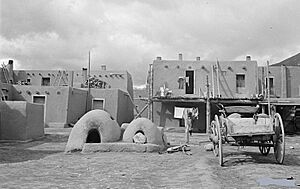
In 2011, the Taos Pueblo Preservation Program received a grant of $800,000 from the U.S. Department of Housing and Urban Development. This money helped hire more workers, especially those skilled in traditional building methods for conservation work. It also funded workshop assistants who help homeowners maintain their traditional adobe homes. Supervisors teach trainees about these traditional methods while rebuilding parts of an 11-unit house that was almost falling apart.
The first part of the conservation plan for Taos Pueblo included building a training center. It also involved restoring 120 to 150 houses, training local people, assessing the compound's structure, and creating a cultural center and tribal archives. The second part of the project was funded by the World Monument Fund. Taos Pueblo is on their watchlist because its culture and structures are at risk. By the end of these efforts, twenty-one adobe houses are expected to be restored. The previous funding also paid for a laser scan of the buildings.
The main goal of Taos Pueblo's conservation is to encourage a community-based approach. This means training local people to manage their own property. It also involves working with government and non-government groups. The project aims to protect the traditional way of life and cultural traditions in the community. In August 2020, the United States Department of Housing and Urban Development announced a grant of $899,754. This money was given to the Taos Pueblo Housing Authority to fix up five housing units. This helped reduce the risk of spreading COVID-19. The grant also provided help with rent, food, and utility bills.
Visual Arts and Pottery
Taos Pueblo is known for its talented artists and traditional art forms. These include silver and turquoise jewelry, heishi bead necklaces, and pottery. Heishi beads are usually made from carved seashells or soft stones. The pueblo’s pottery is special because it uses micaceous clay. This clay contains mica, which gives the pots a shiny orange color when they are fired. These strong, simple ceramics are valued for both their beauty and their usefulness, as they can be used for cooking over open flames or in ovens.
Notable Taos Pueblo People
- Antonio Archuleta, painter
- Trinidad Archuleta, artist
- Ochwiay Biano, elder, political leader
- Pop Chalee, painter
- Juanita Suazo Dubray, potter
- Albert Looking Elk (c. 1888–1940), painter
- Albert Lujan (1892–1948), painter
- Patricia Michaels, fashion designer, textile artist
- Eva Mirabal (1920–1968), comic artist, painter
- Juan Mirabal (1903–1981), painter
- Robert Mirabal, Native American flute–player
- Tomás Romero (revolutionary) (died 1848), military leader
- DeAnna Autumn Leaf Suazo (1992–2021), painter
- Pop Wea, also Lori Tanner (died 1966), painter
See also
- Elk-Foot of the Taos Tribe
- National Register of Historic Places listings in Taos County, New Mexico
- List of National Historic Landmarks in New Mexico
- List of the oldest buildings in New Mexico


